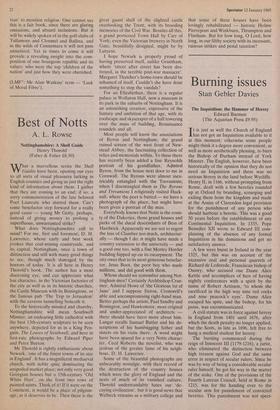Best of Notts
A. L. Rowse
Nottinghamshire: A Shell Guide Henry Thorold (Faber & Faber £8.50)
what a marvellous series the Shell Guides have been, opening our eyes to all sorts of visual pleasures lurking in English counties and giving us just the right kind of information about them. I gather that they are coming to an end; if so, a sorry commemoration of the late beloved Poet Laureate who started them. Can't some benefactor step forward for a really good cause — young Mr Getty, perhaps, instead of giving money to prolong a superfluous, unwarranted strike?
What does Nottinghamshire call to mind? For me, first and foremost, D. H. Lawrence, whose early and best work evokes that coal-mining countryside, and its capital. Nottingham. once a town of distinction and still with many good things to see, though much damaged by the horrors of today. It is all here in Henry Thorold's book. The author has a most discerning eye, and can appreciate what has character, in the Victorian factories of the city as well as in its historic churches, the Castle Museum with its Boningtons, or the famous pub 'The Trip to Jerusalem' with the caverns tunnelling beneath it.
To the historically minded and churchy. Nottinghamshire will mean Southwell Minster, an endearing little cathedral with the best 13th-century sculpture to be seen anywhere, depicted for us in a King Pen- guin, The Leaves of Southwell, and here in first-rate photographs by Edward Piper and Peter Burton.
Mr Thorold is rightly enthusiastic about Newark, 'one of the finest towns of its size in England'. It has a magnificent mediaeval church, with noble spire dominating the unspoiled market place; not only very good Georgian houses but a 15th-century 'Old White Hart', on the front two rows of painted saints. Think of it! If it were on the Continent, it would be a place of pilgrim- age. as it deserves to be. Then there is the great gaunt shell of the slighted castle overlooking the Trent, with its brooding memories of the Civil War. Besides all this, a grand porticoed Town Hall by Carr of York; even the Victorian brewery in North Gate, beautifully designed, might be by Lutyens.
I hope Newark is properly proud of having preserved itself, unlike Grantham, where 'street after street has been des- troyed, in the terrible post-war massacre'. Margaret Thatcher's home-town should be ashamed of itself. Couldn't she have done something to stop the vandals?
For an Elizabethan, there is a regular palace in Wollaton Hall, now a museum in its park in the suburbs of Nottingham. It is an astonishing creation, expressive of the fantasy and ambition' of that age, with its roofscape and skyscraper of a hall towering over the mass of building, Renaissance roundels and all.
Most people will know the associations of Byron and Nottingham; the grand ruined screen of the west front of New- stead Abbey, the fascinating collection of relics and memorials within. To these there has recently been added a fine Reynolds portrait of his grandfather, Admiral Byron, from the house next door to me in Cornwall. The Byrons were almost inex-
tricably entangled with the Trevanions; when I disentangled them in The Byrons and Trevanions I religiously visited Huck- nall, where the poet is buried — we have a photograph of the place, but might have been given a portrait of the man.
Everybody knows that Notts is the coun- ty of the Dukeries, those grand houses and parks of the ducal descendants of Bess of Hardwick. Apparently we are not to regret the loss of Clumber too much, architectur- ally — though I do: it might have made a country extension to the university — and a good one too, with a fine Morley Horder building hipped up on its escarpment. The city owes that to its most generous benefac- tor, Jesse Boot, the poor boy who made millions, and did good with them.
Whom should we remember among Not- tingham men? Certainly Archbishop Cran- mer, Admiral Howe of 'the Glorious 1st of June' and I suppose Ireton, Cromwell's able and uncompromising right-hand man.
Better perhaps the artists, Paul Sandby and Bonington, and Hawksmoor, most original and under-appreciated of architects — there should have been more about him.
Langar recalls Samuel Butler and his de- scriptions of his humbugging father and sisters on his visits there. A word might have been spared for a very Notts charac- t&, Cecil Roberts the novelist, who was jealous of the greater fame of his neigh- bour, D. H. Lawrence.
Some of the beautiful photographs are unbearably nostalgic, with their record of the destruction of the country houses which were the glory of England and the nests of much of its vanished culture. Thorold understandably hates our 'de- caying civilisation', but it is good news that Welbeck remains as a military college and that some of these houses have been lovingly rehabilitated — historic Holme Pierrepont and Winkburn, Thrumpton and Flintham. But for how long, 0 Lord, how long, in our filthy society with its incessant, ruinous strikes and penal taxation?






































 Previous page
Previous page